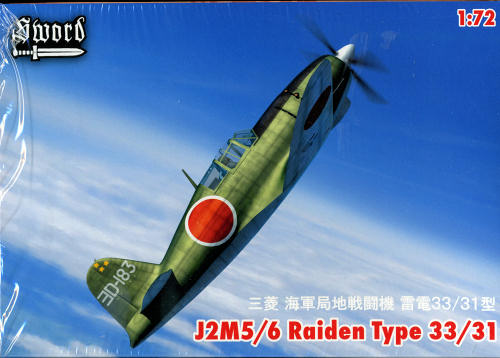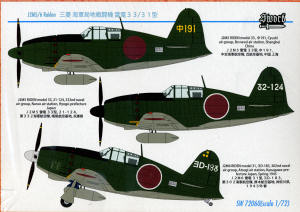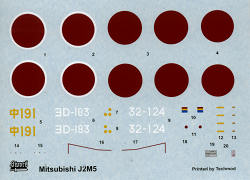
| KIT #: | SW72060 |
| PRICE: | $32.99 SRP |
| DECALS: | Three options |
| REVIEWER: | Scott Van Aken |
| NOTES: | Short run kit |

| HISTORY |
The first few produced J2M2 were delivered to the development units in December 1942 but severe problems were encountered with the engines. Trials and improvements took almost a year and the first batch of the serial built J2M2 Model 11 was delivered to 381st Kokutai in December 1943. Parallel with the J2M2, production of the J2M3 Raiden Model 21 started. The first J2M3 appeared in October 1943 but deliveries to combat units started at the beginning of February 1944.
The Raiden made its combat debut in June 1944 during the Battle of the Philippine Sea. Several J2Ms operated from Guam and Saipan and a small number of aircraft were deployed to the Philippines. Later, some J2Ms were based in Chosen airfields, Genzan (Wonsan), Ranan (Nanam), Funei (Nuren), Rashin (Najin) and Konan under Genzan Ku, for defending these areas and fighting against Soviet Naval Aviation units.
Primarily designed to defend against the B-29 Superfortress, the lack of a supercharger handicapped the aircraft at high altitude. However, its four-cannon armament supplied effective firepower and the use of dive and zoom tactics allowed it to score occasionally. Insufficient numbers and the American switch to night bombing in March 1945 limited its effectiveness. Even in the most expert hands it was vulnerable to the P-51D Mustang, primarily at high altitude.
Captured J2M was U.S. Technical Air Intelligence Command (TAIC) tested in the 92 octane fuel plus methanol, and J2M2 (Jack11) achieved a speed of 655 km/h (407 mph) at 5,520 m (17,400 ft), and J2M3 (Jack21) achieved a speed of 671 km/h (417 mph) at 4,980 m (16,600 ft).
| THE KIT |
 Sword's
short run kits have been improving quite a bit over the years and this one show
it. While these sorts of kits will never reach the quality of Tamiya or Revell,
this one is quite well done with engraved panel lines and well done cockpit
detailing. There is resin in with this one for cockpit sidewall panels, seat,
radio and gun sight. No photo etch is included but it would have been nice to
have p.e. seat belts.
Sword's
short run kits have been improving quite a bit over the years and this one show
it. While these sorts of kits will never reach the quality of Tamiya or Revell,
this one is quite well done with engraved panel lines and well done cockpit
detailing. There is resin in with this one for cockpit sidewall panels, seat,
radio and gun sight. No photo etch is included but it would have been nice to
have p.e. seat belts.
As the kit builds either the J2M5 or J2M6, there are different bits for the two versions. This seems to be limited to cannon barrels for the wings and the oil cooler intake under the nose. The kit also supplies two props with one having wider blades, but no version is specified as to which gets what. Another option is the drop tank with two different designs being provided. If one goes with the markings placement, the one with fins is the one used for all three options.
 The rest
of the build is very straight-forward. This is not a complex kit, but offers a
level of detail not available on other 1/72 J2M kits, especially in the cockpit.
I found it interesting that the armored glass for the pilot is not in the
windscreen, but behind the gun sight.
The rest
of the build is very straight-forward. This is not a complex kit, but offers a
level of detail not available on other 1/72 J2M kits, especially in the cockpit.
I found it interesting that the armored glass for the pilot is not in the
windscreen, but behind the gun sight.
 The
instructions are well drawn with additional drawings to show part alignment and
placement for some of the bits. Paint information is generic. All three markings
options are in Mitsubishi Green over Light Grey. The yellow wing ID bands will
need to be painted as will the nose anti-glare panel. There are markings for two
J2M5s with one being from Cyushi Air Group in Shanghai and the other from the
332nd Naval Air Group in Japan. The lone J2M6 is from the popular Yokosuka Naval
Air Group in early 1945 and has three victory markings on the fin. The decals
are very nicely printed in the proper shades and experience has shown them to be
quite thin.
The
instructions are well drawn with additional drawings to show part alignment and
placement for some of the bits. Paint information is generic. All three markings
options are in Mitsubishi Green over Light Grey. The yellow wing ID bands will
need to be painted as will the nose anti-glare panel. There are markings for two
J2M5s with one being from Cyushi Air Group in Shanghai and the other from the
332nd Naval Air Group in Japan. The lone J2M6 is from the popular Yokosuka Naval
Air Group in early 1945 and has three victory markings on the fin. The decals
are very nicely printed in the proper shades and experience has shown them to be
quite thin.
| CONCLUSIONS |
What with the increasing prices on Hasegawa kits (the only other maker of the J2M in 1/72 that I can think of), this one very much becomes a viable option to the 1/72 builder. With the additional detail given in the kit, it should make into a superb replica.
| REFERENCES |
http://en.wikipedia.org/wiki/Mitsubishi_J2M
May 2012
Thanks to Squadron Products for the preview kit. Get yours at your local hobby shop or have them order one for you.
If you would like your product reviewed fairly and fairly quickly, please contact the editor or see other details in the Note to Contributors.